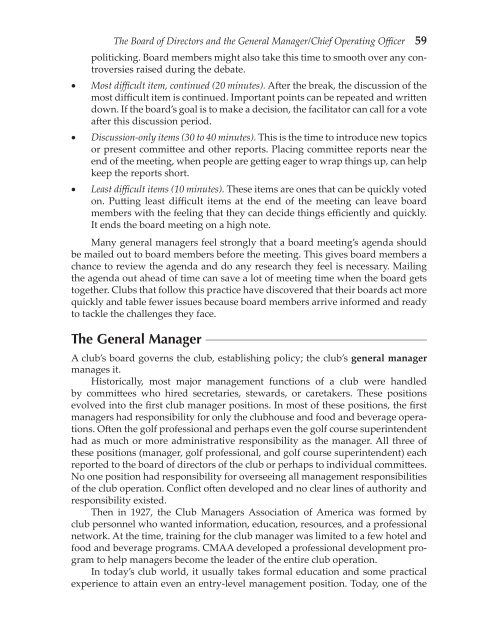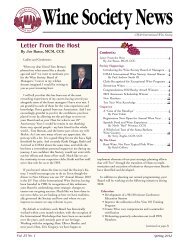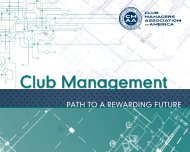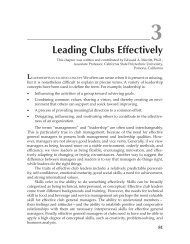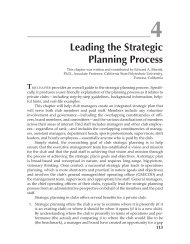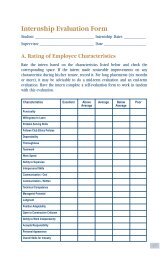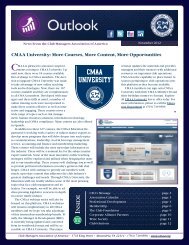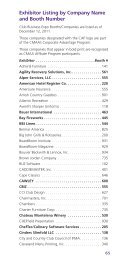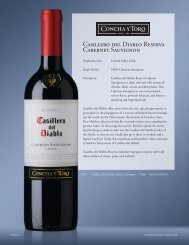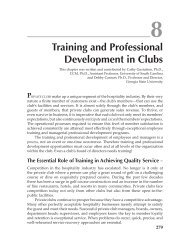The Board of Directors and the General Manager/Chief Operating ...
The Board of Directors and the General Manager/Chief Operating ...
The Board of Directors and the General Manager/Chief Operating ...
Create successful ePaper yourself
Turn your PDF publications into a flip-book with our unique Google optimized e-Paper software.
<strong>The</strong> <strong>Board</strong> <strong>of</strong> <strong>Directors</strong> <strong>and</strong> <strong>the</strong> <strong>General</strong> <strong>Manager</strong>/<strong>Chief</strong> <strong>Operating</strong> Officer 59politicking. <strong>Board</strong> members might also take this time to smooth over any controversiesraised during <strong>the</strong> debate.• Most difficult item, continued (20 minutes). After <strong>the</strong> break, <strong>the</strong> discussion <strong>of</strong> <strong>the</strong>most difficult item is continued. Important points can be repeated <strong>and</strong> writtendown. If <strong>the</strong> board’s goal is to make a decision, <strong>the</strong> facilitator can call for a voteafter this discussion period.• Discussion-only items (30 to 40 minutes). This is <strong>the</strong> time to introduce new topicsor present committee <strong>and</strong> o<strong>the</strong>r reports. Placing committee reports near <strong>the</strong>end <strong>of</strong> <strong>the</strong> meeting, when people are getting eager to wrap things up, can helpkeep <strong>the</strong> reports short.• Least difficult items (10 minutes). <strong>The</strong>se items are ones that can be quickly votedon. Putting least difficult items at <strong>the</strong> end <strong>of</strong> <strong>the</strong> meeting can leave boardmembers with <strong>the</strong> feeling that <strong>the</strong>y can decide things efficiently <strong>and</strong> quickly.It ends <strong>the</strong> board meeting on a high note.Many general managers feel strongly that a board meeting’s agenda shouldbe mailed out to board members before <strong>the</strong> meeting. This gives board members achance to review <strong>the</strong> agenda <strong>and</strong> do any research <strong>the</strong>y feel is necessary. Mailing<strong>the</strong> agenda out ahead <strong>of</strong> time can save a lot <strong>of</strong> meeting time when <strong>the</strong> board getstoge<strong>the</strong>r. Clubs that follow this practice have discovered that <strong>the</strong>ir boards act morequickly <strong>and</strong> table fewer issues because board members arrive informed <strong>and</strong> readyto tackle <strong>the</strong> challenges <strong>the</strong>y face.<strong>The</strong> <strong>General</strong> <strong>Manager</strong>A club’s board governs <strong>the</strong> club, establishing policy; <strong>the</strong> club’s general managermanages it.Historically, most major management functions <strong>of</strong> a club were h<strong>and</strong>ledby committees who hired secretaries, stewards, or caretakers. <strong>The</strong>se positionsevolved into <strong>the</strong> first club manager positions. In most <strong>of</strong> <strong>the</strong>se positions, <strong>the</strong> firstmanagers had responsibility for only <strong>the</strong> clubhouse <strong>and</strong> food <strong>and</strong> beverage operations.Often <strong>the</strong> golf pr<strong>of</strong>essional <strong>and</strong> perhaps even <strong>the</strong> golf course superintendenthad as much or more administrative responsibility as <strong>the</strong> manager. All three <strong>of</strong><strong>the</strong>se positions (manager, golf pr<strong>of</strong>essional, <strong>and</strong> golf course superintendent) eachreported to <strong>the</strong> board <strong>of</strong> directors <strong>of</strong> <strong>the</strong> club or perhaps to individual committees.No one position had responsibility for overseeing all management responsibilities<strong>of</strong> <strong>the</strong> club operation. Conflict <strong>of</strong>ten developed <strong>and</strong> no clear lines <strong>of</strong> authority <strong>and</strong>responsibility existed.<strong>The</strong>n in 1927, <strong>the</strong> Club <strong>Manager</strong>s Association <strong>of</strong> America was formed byclub personnel who wanted information, education, resources, <strong>and</strong> a pr<strong>of</strong>essionalnetwork. At <strong>the</strong> time, training for <strong>the</strong> club manager was limited to a few hotel <strong>and</strong>food <strong>and</strong> beverage programs. CMAA developed a pr<strong>of</strong>essional development programto help managers become <strong>the</strong> leader <strong>of</strong> <strong>the</strong> entire club operation.In today’s club world, it usually takes formal education <strong>and</strong> some practicalexperience to attain even an entry-level management position. Today, one <strong>of</strong> <strong>the</strong>


